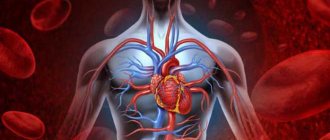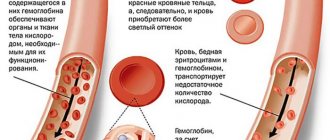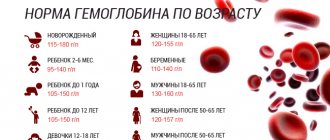Knowing the MSN in a blood test, a discrepancy with the norm, a shift in any direction, it will not be difficult for the doctor to suggest a probable diagnosis, the degree of development of the disease and exclude pathological changes. Having the result in hand, the doctor receives a complete picture of the possible causes that provoked the imbalance of the formed elements.
If you complain of poor health, weakness, hyperthermia and other signs of discomfort, the therapist prescribes a general blood test - an indicative way to establish a diagnosis. Each number in the results has its own acceptable limits and deviations are an alarming sign.
Complex protein
Hb is a complex blood protein. It is present in erythrocytes - red blood cells. The structure of hemoglobin includes an iron ion, which is surrounded by the protein globin. This natural formation performs many different functions in the human body:
- binds oxygen, transferring it from the lungs to all organs and tissues of the human body;
- carries carbon dioxide to the lungs;
- helps normalize the acid-base balance of the blood.
Oxygen is a very important element necessary for the existence of all cells in the body. Without the help of hemoglobin, this element cannot reach them from the lungs, so even a slight decrease in its concentration affects life.
MCHC indicator
In other words, the MCHC indicator is the ratio of the amount of hemoglobin to cellular volume. It can be calculated using a certain formula that takes into account the level of iron-containing protein and hematocrit. The hemoglobin concentration in an erythrocyte does not depend on the cell volume and does not indicate the absolute concentration of iron-containing protein in the erythrocyte. The indicator is measured in grams per deciliter or grams per liter.
It often happens that the average Hb concentration in MCHC red blood cells is reduced. Let's look at what this means next.
Increasing test scores
An increase in MCHC is observed in hyperchromic anemia, for example, in a blood condition caused by vitamin B12 deficiency.
An increase in the average concentration is also observed in the following conditions:
- caused by hyperchromic anemia with spherocytosis, ovalocytosis - phenomena of deformation of the erythrocyte wall;
- lack of vitamin B9;
- hyperosmolarity of red blood cells - caused by significant dehydration when the loss of water is greater than the removal of salts from the cell, for example, in patients with diabetes.
General analysis
To determine the deviation, the patient is assigned a general analysis. Biological fluid is donated on an empty stomach in the morning, blood is drawn from a finger in a laboratory setting. An important factor in the correctness of the analysis indicators is compliance with the rules of preparation for it, for example, refusing to eat at least 8 hours before the study. In addition, you should not drink alcohol or other drinks, with the exception of water. Experts obtain the result using a special hematology analyzer.
Why is the average concentration of Hb in an erythrocyte reduced?
MCHC in blood test is elevated - causes, diagnosis, methods of correction
The MCHC parameter is used to determine the number (maximum) of hemoglobin cells carried by red blood cells and evaluate the efficiency of their work.
The MCHC indicator is calculated by dividing the hemoglobin content by the number of red blood cells in the corresponding volume of blood. The permissible hemoglobin concentration is in the range of 280 – 380 g/liter.
Individual parameter values are set for each age category.
Purpose of mchc measurement
As already mentioned, in the process of laboratory research, a specialist calculates the quantity and determines the qualitative composition of the main components of blood. Among them:
- red blood cells;
- leukocytes;
- platelets.
In fact, a test that determines blood mchc is very important. After all, the transfer of hemoglobin through tissues and organs is one of the most important functions of red blood cells. Consequently, the condition of the entire organism depends on how efficiently red blood cells work.
The mchc level can only be determined by taking blood for analysis. Decoding the results gives an idea of how much high-quality hemoglobin is contained in the patient’s circulatory system.
Decrease in MCHC - reasons
Low MCHC may indicate a condition such as hypochromia. It is characterized by the fact that red blood cells are not sufficiently saturated with hemoglobin. This condition is caused by pathologies in which the production of iron-containing protein is disrupted. Hypochromia is also provoked by various types of anemia, lead poisoning, hypovitaminosis, and some congenital hereditary diseases. In addition, it may be associated with impaired iron metabolism in the body. The average Hb concentration in an erythrocyte may be reduced for the following reasons:
- Hypochromic and sideroblastic iron deficiency anemia.
- Posthemorrhagic anemia of chronic type.
- Hemoglobinopathies, in which hemoglobin synthesis is disrupted, certain amino acids are replaced in its chains.
- Disruption of water-electrolyte metabolism processes.
- Megaloblastic anemia, in which red blood cells increase in volume more significantly than these elements are saturated with iron-containing protein.
- Thalassemia (some varieties) is a hereditary disease caused by the presence of mutations in genes that are responsible for the formation of iron-containing proteins.
When hemoglobin production is impaired, MCHC decreases last. Therefore, a decrease in the level of iron-containing protein with normal values of other blood elements (hemoglobin and red blood cell content) indicates erroneous laboratory test results.
Is it dangerous when the average concentration of Hb in the erythrocytes of the MSHC is reduced? Let us examine it further.
High level reasons
Elevated hemoglobin levels are diagnosed less frequently than low hemoglobin levels, but are also a pathological symptom. This condition is accompanied by excessive (more than 35 pg) and persistent saturation of blood cells with hemoglobin and is observed with:
- Respiratory diseases.
- Smoking.
- Dehydration.
- Living in high mountains.
- Taking hormonal and anticonvulsant medications, cytostatics.
Increased saturation of red blood cells with hemoglobin is accompanied by:
- dizziness, tinnitus, flickering of spots before the eyes;
- hyperemia (redness) of the skin and mucous membranes;
- numbness of the limbs, muscle weakness;
- chest pain;
- constipation, loss of appetite;
- aversion to meat food;
- shortness of breath.
MCH function
MCH in a blood test functions as the element that colors human blood red. Due to its specific structure, hemoglobin can bind several elements (carbon dioxide, carbon dioxide and oxygen) present in the blood at once, for their subsequent movement to organs through the circulatory system.
In adults, the average hemoglobin value is considered a constant unit, but in children this value fluctuates either down or up. But in the absence of preparation for the study (general blood test), the results may show that the average level of hemoglobin in the red blood cell is decreased or increased, and this can be considered a false result for an adult patient. Why else might the average Hb concentration in an erythrocyte be reduced?
How to increase hemoglobin?
What to do? In order to increase hemoglobin in the blood, you need to know the reason for its drop, just in case. You can consume foods that increase hemoglobin (iron, B vitamins) as much as you like, but if they are not properly absorbed in the gastrointestinal tract, then you may not achieve success.
The main pathogenetic method of therapy is taking iron-containing drugs (Heferol, Ferroplex, Ferlatum and others). As a rule, oral forms are prescribed, but in severe cases the drugs are recommended to be administered parenterally. Treatment of patients prone to intestinal dysfunction involves the parallel administration of enzyme and coating drugs.
If the prescribed medications are well tolerated, they are used in maximum doses, followed by maintenance therapy with a reduction in dosage over several months. At the same time, be sure to monitor the level of iron in red blood cells and blood serum. If necessary, vitamin B12, B9 and ascorbic acid are also prescribed. In severe cases, they resort to transfusion of whole blood or red blood cells.
Other reasons for deviation from the norm
Low hemoglobin is the body's natural reaction to iron deficiency. In addition to the main ones, there are several more reasons why the concentration of Hb in erythrocytes is reduced:
- Blood loss (acute or chronic). If the body is subjected to a single severe or systematic blood loss, then, as a result, the level of hemoglobin in the blood begins to decrease. This can occur due to injury, surgery, or certain pathologies. This condition is often observed in women, and the reason for the decrease in hemoglobin concentration may be polymenorrhea (heavy and prolonged menstruation). Low hemoglobin is also diagnosed in women who have had uterine fibroids, ovarian cysts or ectopic pregnancy. The reason may also be hidden in regular nosebleeds, internal bleeding, with the development of diseases of the digestive tract, and dental pathologies.
- Short lifespan of red blood cells. This factor is due to the occurrence of autoimmune diseases if the body is exposed to infection, or in the case where the decrease in red blood cells is a hereditary disease.
- Poor nutrition. The reason that the Hb content in the MCH red blood cell is reduced may be due to a lack of iron coming from organic foods. Microelements, animal proteins and vitamins do not enter the body in sufficient quantities if the patient refuses to eat meat for a long time. An unbalanced diet leads to dysfunction of the reproductive system in women and insufficient production of hormones.
- The average HB content in an MCH erythrocyte is reduced due to intoxication of the body. Anemia can develop during acute poisoning, during the presence of parasites in the body, and during frequent stressful situations.
- Blood pathologies. Destruction of red blood cells and a decrease in hemoglobin can develop as a result of blood pathologies, in the presence of malignant tumors and disorders of the bone marrow.
- Chronic diseases. In infectious diseases (enterocolitis, tuberculosis, hepatitis, pyelonephritis), a redistribution of iron occurs in the blood, which provokes a low level of hemoglobin.
- Pregnancy. A decrease in hemoglobin can occur in women during pregnancy, breastfeeding and postpartum recovery. This is due to the very intensive use of iron in the body, which is necessary to maintain vital functions.
What are the consequences of a reduced Hb concentration in an erythrocyte?
Low hemoglobin during pregnancy
Low hemoglobin during pregnancy is a common occurrence for expectant mothers. A significant deviation from the norm can negatively affect the health of both mother and baby. This is fraught with the following complications:
- hypotension of the uterus (decreased contractility of its muscles);
- hypoxia (oxygen starvation of the fetus);
- delay or even cessation of fetal growth and development;
- low birth weight;
- disturbances in the functioning of the respiratory and nervous systems.
In addition, many doctors are confident that low hemoglobin in a woman during childbirth can negatively affect the child’s health in the future. Such children do poorly at school, often get sick, and suffer from various pathologies of internal organs. Therefore, if during pregnancy it is below normal, treatment under the supervision of a doctor is extremely necessary.
Consequences
The consequences of low hemoglobin act as the root causes of the development of anemia, due to a lack of iron in the blood. Low hemoglobin causes a decrease in the oxygen saturation of body tissues and puts a significant strain on the functioning of all systems and organs. Hemoglobin transports carbon dioxide from the lungs throughout the body and helps stabilize the acid-base balance in the internal environment.
A decrease in hemoglobin concentration contributes to a deterioration in overall health, provokes drowsiness, dizziness, apathy and a decrease in blood pressure. Because hemoglobin is a molecular compound of iron and protein in blood cells, it not only carries oxygen to the body, but is also considered an important biochemical component for many organic reactions. As a result of a decrease in hemoglobin in the blood, oxygen starvation occurs in the human body, which has such names as “hypoxia”, “anemia”, “anemia”.
The danger of anemia as you age
With age, the risk of anemia increases and the consequences for life and health worsen. First of all, there is a negative effect on the heart and blood vessels. Myocardial ischemia develops, which can be complicated by a heart attack, signs of atherosclerotic diseases appear, blood vessels lose their elasticity, and plaques and blood clots form in their lumens. Due to a decrease in hemoglobin, frequent headaches, decreased attention and memory may appear. In severe situations, cerebral circulation is disrupted.
What is the standard indicator?
To independently understand whether the level of hemoglobin in the body is reduced or not, you need to know what the normal indicators of this element are. This value depends on age, and the norms for iron-containing protein are as follows:
- newborn children - 115-180 g/l;
- 2-6 months – 95-140 g/l;
- 6-12 months – 105-150 g/l;
- 1-12 years – 105-150 g/l;
- girls 12-18 years old – 112-152 g/l;
- boys 12-18 years old – 120-160 g/l;
- men aged 18-65 years – 130-160 g/l;
- men over 60 years old – 125-165 g/l;
- women in the age range from 18 to 60 – 120-150 g/l;
- women 60 years of age and older – 117-138 g/l;
- women during pregnancy – 110-140 g/l.
We looked at what it means when the average concentration of Hb in red blood cells is reduced. We described the causes of the pathology in detail.
Increased MCHC in blood test
The condition of the main body fluid – blood – is the most important indicator of human health. Blood is a kind of conductor of nutrients and oxygen to all tissue structures, ensuring their normal functioning. Therefore, any violation of the components of its formula can negatively affect the activity of the entire organism.
So, in the case of pathological changes in red blood cells - erythrocytes, and more specifically one of their components - the protein compound hemoglobin - the cells will lack oxygen, which will certainly affect the human condition. To determine such a disorder, it is enough to conduct a general blood test (CBC), which will show the main parameters of hemoglobin and other indicators.
The average hemoglobin content in red blood cells is determined by two coefficients, abbreviated in the form as MCHC and MCH. A decrease in these indicators is a fairly common pathology, while a condition in which the level of MCH and MCHC in a blood test is increased is observed much less frequently, but poses no less a threat to the body.
What do the abbreviations MCH and MCHC stand for?
A general blood test, or as it is also called a clinical blood test, allows specialists to evaluate not only the hemoglobin (Hb) content, but also its average concentration in an individual red blood cell (MCH). In addition, the average value of bound Hb or corpuscular is determined in parallel, which is indicated in the form as MCHC.
The average corpuscular hemoglobin value is not a diagnostic indicator, but rather a value confirming the reliability of MCH. That is, when the latter changes, shifts in the MCHC coefficient are also observed. The indicator is determined by calculation using a special formula, which involves dividing the total hemoglobin content by the hematocrit value and multiplying by 100.
Reference! MCHC does not depend on the total volume of cells and makes it possible to assess their saturation with hemoglobin, which makes it possible to determine the presence of disturbances in the process of formation of this protein compound. Normal MCHC levels in red blood cells are considered to be 300-380 g/l, although they may vary slightly depending on the age and gender characteristics of the subjects.
Normal parameters for different age and gender groups
The values of this indicator have slight differences, which is determined by the development or extinction of metabolic processes, including the factor of blood cell production. Among male and female representatives, some differences are also noted, which, of course, is taken into account when deciphering research materials.
Thus, the boundaries of the norm are determined as follows. Children under 12 years of age. At this age, gender characteristics do not affect this indicator. In newborns, values of 280-350 g/l are taken as normal. In children older than MCHC increases to 370 g/l and does not change until the age of 12 years.
Teenagers under 18 years of age. At this age, the indicators for boys and girls will differ; this is due to the onset of puberty and the characteristics of the body’s restructuring. For boys, MCHC should not exceed 380 g/l, while for girls it should not exceed 370 g/l. The latter have slightly low values, this is due to regular blood loss during menstruation.
In adult men and women of reproductive age (up to 45-50 years), the indicators do not differ significantly and can vary from 320 to 380 g/l. In older people, MCHC values gradually decrease as they age, which is explained by a decrease in the activity of all processes in the body, including cell production.
MCHC norms for different age groups and both sexes
Reasons for increasing the coefficient
MCHC, like all diagnosed indicators, can undergo changes in both directions - increase and decrease. Many people know about its reduction - mainly various types of anemia (decreased hemoglobin amount) that arise as a result of a wide variety of factors.
However, an increase in this parameter will not always be the result of the development of the disease. Sometimes this indicator is caused by reasons related to poor-quality collection of biomaterial, for example, a poorly washed test tube. Also, in some laboratories the conditions for storing blood are not observed (due to workload, the analysis is performed untimely).
This leads to the occurrence of undesirable processes in the sample taken. The amount of hemoglobin may increase, and therefore the result is unreliably increased. If the subject feels well and is not bothered by any pathological manifestations, then the procedure should be carried out again and preferably in some other laboratory.
Blood test for fibrinogen
In other cases, if MCHC is increased, then pathology is most likely present. Often, deciphering this parameter makes it possible to identify the disease at an early stage, which means it makes it possible to carry out therapy using more gentle methods, and in a short time.
So, an increase in MCHC and MCH may be evidence of:
- lack of B vitamins;
- alcoholism or nicotine addiction;
- taking sedatives or hormonal medications.
Dysfunction of the bone marrow or liver can also increase these blood counts. One of their fairly common causes of increase is erythremia, a blood condition in which a large number of red blood cells and hemoglobin are formed. This is an extremely dangerous disorder of the circulatory system, which can lead to arterial thrombosis or diseases of the duodenum.
This condition can be determined by the presence of redness of the skin, combined with pain, unbearable itching and complaints of pain in the arms and legs. To confirm or refute this diagnosis, of course, one general blood test will not be enough, so a full examination of the patient’s body is carried out.
Reference! If one of the components of the blood formula is destroyed, the indicator of red blood cell activity will also be increased. Similar phenomena can be observed after severe traumatic injuries, accompanied by heavy blood loss, or in women after childbirth.
In addition to the above, MCHC may increase due to hypochromic anemia, diabetes mellitus, dehydration, heart and pulmonary failure, as well as any neoplasms in the renal parenchyma. All these diseases require regular monitoring of basic blood parameters and appropriate therapy.
Another, and perhaps the most dangerous reason for the increase in the described indicator, is a blood disease associated with a change in the shape of red blood cells - erythrocytes. This pathology is called spherocytosis, and it refers to hereditary, genetically determined diseases - hypochromic anemia. But in rare cases it can be a consequence of hemolytic anemia.
Spherocytosis as one of the reasons for increased MSHC
The main characteristic of this disease is a pathological change from the biconcave shape of the erythrocyte membrane to a spherical one. Such blood cells do not have the ability to efficiently perform the function of transporting oxygen, and are destroyed much faster. The round shape is a definite marker for the spleen, which is responsible for their destruction.
The nature of changes in erythrocytes during spherocytosis
As a result, the spleen destroys modified red blood cells, mistaking them for those that need to be destroyed, for example, at the end of the life cycle or due to inferiority. This situation leads to a decrease in the number of red blood cells, which, due to their characteristics, are not able to synthesize hemoglobin, which is why much more of it is formed.
The disease can occur in acute and chronic forms, and sometimes its symptoms are quite mild, which causes practically no discomfort to the person. But in some cases they can be so severe and pose a threat to health and even life. Especially often, aggravation of symptoms is observed after suffering from infectious and viral diseases.
Main manifestations of spherocytosis
As noted above, the symptoms of the disease can be obvious, severe or mild, perhaps even so much so that the patient is unaware of its presence until almost the moment he takes a blood test and finds that MCHC is elevated. But, basically, people suffering from spherocytosis present the following complaints, and they have symptoms such as:
- causeless weakness, fatigue, shortness of breath, irritability;
- dysfunction of the digestive system - nausea, vomiting, diarrhea;
- pallor or yellowness of the skin and mucous membranes;
- hemolytic anemia (destruction of red blood cells);
- formation of calculi (stones) in the gall bladder.
Reference! All these signs, regardless of whether they occur in combination or appear as individual symptoms, are already sufficient reason to conduct a general blood diagnosis. Perhaps this is not spherocytosis, but there is a high probability that there are still deviations in the blood count to one degree or another.
In childhood, this pathology is largely due to hereditary predisposition and only in very rare cases is it caused by any infectious or viral diseases.
It is worth noting that hereditary spherocytosis mainly affects children of the Caucasian race, and it occurs in a ratio of 1:5000.
Moreover, in 25% of cases of the total number of diseases there is no genetic history, and the emergence of a new series of mutations is observed.
In children, in addition to the general signs of the disease listed above, splenomegaly is added - an increase in the size of the spleen or its aplasia due to the introduction of viruses.
Anemia can occur in a compensatory form, that is, hemolysis occurs with normal hemoglobin levels.
Within the same family, the symptoms of spherocytosis can be quite variable, and the course of the disease can vary in severity.
Clinical manifestations of spherocytosis in blood tests
Methods for correcting the indicator
To bring the indicator back to normal, it is necessary first, with the help of additional research, to understand the causes that caused it and then develop an appropriate therapeutic approach.
If the change in the coefficient is associated with a disease, then primary attention should be directed to curing the underlying pathology.
In cases where no serious illness is detected, the MSHC level is simply corrected using a certain series of medications and nutrition.
Therapy for decreased MSHC
If the level is low, medications that can increase hemoglobin concentration are usually prescribed. In addition, it is additionally recommended to take folic acid and mineral complexes. When this indicator is restored, it is imperative to include B vitamins in therapy.
If a lack of hemoglobin in red blood cells is diagnosed in a child, then from an early age drugs such as Ferrum Lek, Actiferrin, Maltofer can be prescribed.
After 3 years of age, children can be given Ferroplex, Tardiferon, Totema, etc. These medications are made based on natural ingredients and are therefore recommended for young patients.
Adults are also prescribed these medications, only in higher dosages.
The average course of therapy lasts 1-3 months. The duration of treatment and the frequency of taking medications depend on the patient’s condition and the individual characteristics of his body. If, due to certain contraindications, it is not possible to select an oral drug, the patient is hospitalized in a hospital and, under the supervision of medical staff, is given a course of intravenous and intramuscular injections.
It is recommended to add foods that contain large amounts of iron to drug therapy. This is the liver of animals and birds, red meat, apples, buckwheat. In addition, it is necessary to add foods high in folic acid to the patient’s diet. These include citrus fruits, nuts, cereals, corn, carrots, beets, cabbage, pumpkin, tomatoes, apples, apricots, pears, etc.
Treatment for increased MSHC
If, during the decoding of the CBC data, it turns out that the MSHC indicator is elevated, then the first step to reduce its level is to drink plenty of fluids in combination with eating salty foods.
Shilajit helps well with this condition. You should also completely remove all red fruits, red meat, liver and grains from your diet.
They need to be replaced with legumes, chicken, dairy products, seafood and vegetables.
The patient must give up alcohol, fatty and fried foods. It is strictly forbidden to take multivitamins that contain B vitamins and folic acid. If the level is sufficiently high, the drugs Cardiomagnyl, Trental, and Curantil are prescribed.
Among the non-drug remedies, hirudotherapy is widely used - leeches not only suck out the blood, but also inject a special substance into it that prevents thickening. Therefore, despite their very unattractive appearance, they are an excellent treatment option for this condition.
Source: //apkhleb.ru/krov/povyshenie-mchc-analize-krovi











